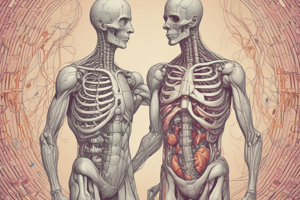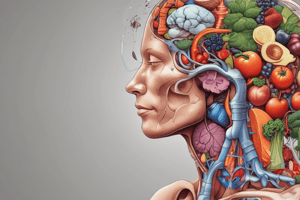Podcast
Questions and Answers
What separates the thoracic cavity from the abdominopelvic cavity?
What separates the thoracic cavity from the abdominopelvic cavity?
- Diaphragm (correct)
- Peritoneum
- Pleura
- Pericardium
Which organ is situated in the mediastinum?
Which organ is situated in the mediastinum?
- Heart (correct)
- Kidneys
- Stomach
- Liver
What is the primary function of homeostasis?
What is the primary function of homeostasis?
- To maintain stable internal conditions (correct)
- To grow and develop
- To respond to external stimuli
- To reproduce offspring
What is referred to as 'homeostatic imbalance'?
What is referred to as 'homeostatic imbalance'?
Which of the following correctly describes the appendicular body region?
Which of the following correctly describes the appendicular body region?
What is the primary study focus of anatomy?
What is the primary study focus of anatomy?
Which level of structural organization comes right after the molecular level?
Which level of structural organization comes right after the molecular level?
In which anatomical position are the palms facing?
In which anatomical position are the palms facing?
What does the midsagittal plane divide the body into?
What does the midsagittal plane divide the body into?
What are the subdivisions of the dorsal cavity?
What are the subdivisions of the dorsal cavity?
Flashcards are hidden until you start studying
Study Notes
Introduction to Anatomy and Physiology
- Anatomy refers to the study of body structures and their interrelationships.
- Physiology focuses on how those body structures function.
Levels of Structural Organization
- Chemical level: Atoms combine to create molecules.
- Cellular level: Cells are formed from molecules.
- Tissue level: Similar cells group to form tissues (e.g., smooth muscle tissue).
- Organ level: Different tissues work together to form organs (e.g., heart).
- Organ system level: Various organs collaborate to perform complex functions (e.g., cardiovascular system).
- Organism level: The complete human body, composed of multiple organ systems.
Anatomical Position
- Body is erect with feet slightly apart.
- Palms face forward and thumbs point away from the body.
Directional Terms
- Help describe the locations and relationships of body parts to one another.
Body Planes
- Sagittal Plane: Divides body into right and left portions.
- Midsagittal Plane: A sagittal plane along the midline.
- Frontal (Coronal) Plane: Divides the body into anterior and posterior sections.
- Transverse (Horizontal) Plane: Divides the body into superior and inferior parts.
Body Cavities
- Dorsal Cavity: Protects the nervous system; includes cranial and vertebral cavities.
- Ventral Cavity: Houses internal organs; divided into thoracic and abdominopelvic cavities.
- Thoracic Cavity: Contains lungs (pleural cavity) and heart (mediastinum).
- Abdominopelvic Cavity:
- Abdominal part includes organs like the liver and stomach.
- Pelvic part contains bladder and reproductive organs.
Abdominal Regions and Quadrants
- Nine Abdominopelvic Regions: Used for detailed description of abdominal area.
- Four Abdominopelvic Quadrants: Right upper, left upper, right lower, left lower.
Body Regions
- Axial Region: Includes head, neck, and trunk.
- Appendicular Region: Consists of limbs or appendages.
Homeostasis
- Defined as the ability to maintain a stable internal environment amidst external changes.
- Involves regulation of chemical, thermal, and neural factors for equilibrium.
- Essential for survival and energy processing of organisms.
Homeostatic Imbalance
- Occurs when homeostasis is disrupted, potentially leading to positive feedback mechanisms that may cause disease or death.
- Example: A sudden drop in blood pressure can lead to system failure.
Summary of Key Concepts
- Anatomy: Structure and relationships of body parts.
- Physiology: Function of body systems.
- Body Planes: Sagittal, midsagittal, frontal, transverse for anatomical referencing.
Studying That Suits You
Use AI to generate personalized quizzes and flashcards to suit your learning preferences.




